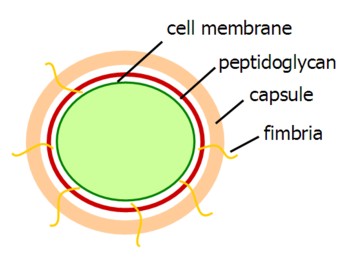
Bacteria
last authored: Feb 2010, David LaPierre
last reviewed:
Introduction
There are thousands of types of bacteria living in and on the human body, though most are harmless. Around the world, the number of bacteria is estimated at 4-6 x 1030 (Whitman et al, 1998). The following is a listing of bacteria that many health care students and professionals will regularly encounter, and should be familiar with. Included in this list are the mycoplasmas, which are distinct from, but related to, other bacteria.
Listing of Important Bacteria
Bacteria are named with a genus (ie Escherischia) and a species (ie coli). They can also have strains.
Classification of Bacteria
Understanding families of bacteria can assist in their identification. The gram stain represents fundamental differences among bacteria. Gram positive have a thick peptidoglycan layer on their surface.
- gram +ve cocci
- gram -ve rods
- gram +ve rods
- gram -ve cocci
- anaerobes
- atyical bacteria
- spirochetes
Gram Positive Cocci
Staphylococci grow in clusters of spherical cells. The two main pathogens are S. aureus and S. saphrophyticus, though coagulase-negative Staph can also cause opportunistic infections.
Staph are able to survive many environmental or chemical attempts at eradication.
Colonies are larger. They are aerobic.
Staphyococci are found throughout the body, especially on the skin. They can secrete a number of enzymes and toxins. A. aureus can be distingished from other species of Staph through the production of coagulase.
Streptococci grow in chains of round cells. Most are harmless, though there are a number of important pathogens. They are organized according to their behaviour on blood agar plates. Most pathogens are beta-hemolytic.
- beta-hemolytic strep produce clear areas around colonies (S pyogenes)
- alpha-hemolytic strep cause the media to turn green (S pneumoniae)
Streptococci carry out fermentation, not respiration, making them anaerobes. However, many are able to grow in air, making them oxygen-tolerant anaerobes.
They grow in small colonies.

Gram Negative Rods
Gram negative rods are a large family containing many pathogens.
Enteric bacteria (Enterobacteriacae) are perhaps the most important.
- Escherichia coli
- Samonella enteriditis
- Shigella dysenteriae
- Klebsiella pneumoniae
- Proteus mirabilis
- Enterobacter spp
- Serratia marcensens
- Citrobacter
- Morganella
- Providencia
- Yersinia spp
Other key gram negative bacteria include:
Some bacteria are 'fastidious', requiring complex nutrients. These include:
- Hemophilus influenzae
- Bordetella pertussis
- Bartonella
- Francisella
- Brucella
- Legionella pneumophilia
gram positive rods
These bacteria are very common but rarely cause disease in the developing world. An important agent in the developing world is Corynebacterium diphtheriae. Other Corynebacteria live on the skin and mucous membranes and can cause opportunistic infections.
Listeria monocytogenes is another gram positive rod which can be dangerous for pregnant women, infants, and immunocompromised.
Spore-forming rods live in the sold and can be large, measuring 3-5 um in length. Endospores develop in the cytoplasm and may remain dormant for long periods. Germination may occur to form a new cell once appropriate conditions exist.
Bacillus is an aerobic generus containing B. anthracis, the agent of anthrax.
Clostridium is a strict anaerobe genus. It contains C. difficile, C. botulinum, C. tetanii, and C. perfringens.
Relatives of the mycobacteria form complex structures. These include the genera Nocardia (aerobic) and Actinomyces (anearobes)
Gram negative cocci
Gram-negative cocci include many important types of bacteria, though the most important is Neisseria. There are many harmless organisms, but N. gonorrhaea and N. meningitidis can be extremely dangerous.
Their outer membranes contain endotoxin.
Anaerobes
Propionibacterium spp
These bacteria are distinguished by the fact that they will only grow anaerobically.
These include: Bacteroides, the most common bacteria in the intestinal lumen. They are also present in gingival pockets. They are normally harmless, but can be pathogenic if they form an abscess or following intestinal perforation.
Actinomyces is a gram positive rod.
Atypical Bacteria
acid-fast bacteria can withstand many chemicals, and they do not stain with the gram. The most important members of this group include Mycobacterium tuberculosis, Mycobacterium leprae, and Mycobacterium avium-intracellulaire.
Spirochetes are helical, spring-shaped bacteria. They most important spirochetes include Treponema pallidum (cause of syphillis), Leptospira (icterohemorrhagic fever), Borrelia burgdorferi (Lyme disease), and Borrelia recurrentis (relapsing fever).
Chlamydiae are small bacteria that can only grow intracellularly, receiving nutrients from host cells. Chlamydia trachomatis causes the sexually transmitted disease chlamydia and other diseases, while Chlamydophyla pneumoniae causes pneumonia.
Rickettsiae are small, intracellular parasites. Ehrlichia infect leukocytes and are transmitted by arthropods. Coxiella burnetii is the cause of Q fever.
Mycoplasma are distant relatives of bacteria. They lack a rigid cell wall, making them resistant to penicillins and other cell wall antibiotics. They also have special nutrient requirements. The most important mycoplasmas are Mycoplasma pneumoniae, which causes pneumonia, and Ureaplasma urealyticum
Spirochetes
Immune Response to Bacterial Infection
Both the innate and adaptive immune system responds to extracellular bacteria
Innate Immune System
- neutrophils
- complement C3b (opsonization)
- macrophages
Adaptive Immune System
- antibody-mediated opsonization
- fix complement C1
- neutralize toxins
- block attachment (invasion)
Response to Intracellular Bacteria
- killed bacteria lead to antigen uptake
- Listeria lives in macrophage cytoplasm, and MHC I presentation leads to CTL response. Th1 expression of IFN-gamma leads to macrophage activation.
- Tuberculosis infection wards off lysosomal fusion, making MHC I presentation unlikely. Th1 cell expression of IFN-gamma leads to macrophage activation
Resources and References
Whitman WB, Coleman DC, Wiebe WJ. 1998. Prokaryotes: the unseen majority. Proc Natl Acad Sci U S A. 9;95(12):6578-83.
